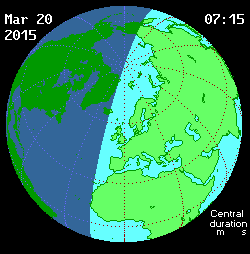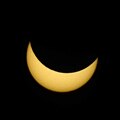| Total eclipse | |
 From Longyearbyen, Svalbard | |
| Gamma | 0.9454 |
|---|---|
| Magnitude | 1.0445 |
| Maximum eclipse | |
| Duration | 167 s (2 min 47 s) |
| Coordinates | 64°24′N6°36′W / 64.4°N 6.6°W |
| Max. width of band | 463 km (288 mi) |
| Times (UTC) | |
| Greatest eclipse | 9:46:47 |
| References | |
| Saros | 120 (61 of 71) |
| Catalog # (SE5000) | 9541 |
A total solar eclipse occurred at the Moon's descending node of orbit on Friday, March 20, 2015, [1] with a magnitude of 1.0445. A solar eclipse occurs when the Moon passes between Earth and the Sun, thereby totally or partly obscuring the image of the Sun for a viewer on Earth. A total solar eclipse occurs when the Moon's apparent diameter is larger than the Sun's, blocking all direct sunlight, turning day into darkness. Totality occurs in a narrow path across Earth's surface, with a partial solar eclipse visible over a surrounding region thousands of kilometres wide. Occurring about 14 hours after perigee (on March 19, 2015, at 19:40 UTC), the Moon's apparent diameter was larger. [2]
Contents
- Event
- Simulation
- Impact
- Coincidence of events
- Religious significance
- Eclipse timing
- Places experiencing total eclipse
- Places experiencing partial eclipse
- Eclipse visibility
- Eclipse details
- Eclipse season
- Related eclipses
- Eclipses in 2015
- Metonic
- Tzolkinex
- Half-Saros
- Tritos
- Solar Saros 120
- Inex
- Triad
- Solar eclipses of 2015–2018
- Saros 120
- Metonic series
- Tritos series
- Inex series
- References
- Bibliography
- External links
Totality was visible in the Faroe Islands and Svalbard. A partial eclipse was visible for parts of Greenland, Europe, North Africa, Central Asia, and western Russia. This total solar eclipse is notable in that the path of totality passed over the North Pole.
The longest duration of totality was 2 minutes and 47 seconds off the coast of the Faroe Islands. It was the last total solar eclipse visible in Europe until the eclipse of August 12, 2026. [3]






















































































































